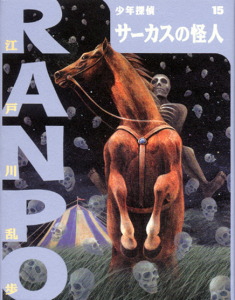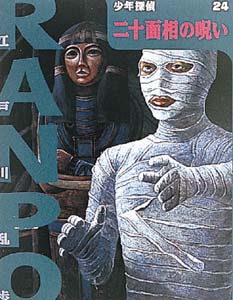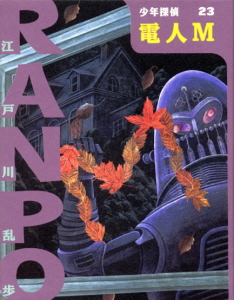The Fiend With Twenty Faces (怪人20面相)
By Edogawa Ranpo (江戸川 乱歩)
Edogawa Ranpo, born as Taro Hirai in 1894, was heavily influenced by Western writers. So heavily influenced that his moniker Edogawa Ranpo is derived from the Japanese pronunciation of Edger Allen Poe. While accredited as the father of the modern Japanese mystery novel, he received much of his inspiration from genre pioneers Sir Arthur Conan Doyle and Maurice Leblanc. He created a number of memorable characters over the course of his writing career which spanned from the mid 20’s to the mid 50’s, the most well-known being Kogoro Akechi. Akechi is a brilliant but slightly eccentric detective; Edogawa’s take on Sherlock Holmes. He generally avoids contact with the police unless they come to him first and is assisted by his adopted twelve-year-old son Yoshio Kobayashi. The young Kobayashi is in turn is leader of the Boy’s Detective Club, a group of Kobayashi’s classmates who act as Kobayashi’s eyes and ears. Akechi may be the ringleader, but the kids are the stars of the show

The Boxcar Kids would totally loose their shit right about now
In 1936, Ranpo was approached to write a new mystery series for Shonen Club, a serialized monthly magazine aimed at young boys. This came as quite a surprise to the author, whose works were purely adult in nature, dripping with the occult and grotesque sexual acts.
At the time Japan was intensifying its invasion of Asia and a majority of pulps were being written to glorify the war. Publications were hit hard. Rampo himself was in a slump, unable to write the stories he wanted in fear of political counterattack. The editors wanted to mix up the stagnating field of juvenile literature by introducing an adult protagonist for a change, and with Akechi as the perfect man for the job, the troubled author was in no position to say no. Naturally, the perfect detective needs the perfect rival.
Enter The Fiend With Twenty Faces, gentlemen thief extraordinaire. A master of disguise, his true identity is so canceled that it is whispered that even the man himself has forgotten what he looks like. Modeled after Leblanc’s detective thief Arsene Lupin (Lupin the Third fans take note), The Fiend is motivated in his theft of rare art and jewels not by money, but out of sport. He announces his appearance through a letter sent to the unfortunate owner of the object he plans to pilfer, detailing the time and date of his crime. Each sentence reads as a smarmy smirk. And as a true gentleman he is always true to his word.
 The Fiend prepares to mummy-choke Johnny Quest for being a poser
The Fiend prepares to mummy-choke Johnny Quest for being a poser
Rampo’s world is laid lout like a giant game of mousetrap. Every setting, character, and detail acts as another peace to the puzzle. Then when you least expect it, down comes the net. The Fiend may be a peerless thief, but he is far from perfect and the arrogance bred from his genius is often his downfall. Each story ends with his capture, while the next begins after his presumed escape. And when no one knows what he really looks like, how can you be sure you’ve even caught the right man?
Mystery pulps up until The Fiend’s appearance have been about suspension of disbelief. Ranpo wanted to suspend belief by its neck until it turned blue in the face. The characters are impossibly astute, the crimes impossibly perfect. They weave effortlessly from scene to scene as actors performing a well-scripted play. Akechi and The Fiend regard each other with a kind of mutual respect. The characters are never in any real danger-The Fiend needs Akechi alive to sensationalize his crimes; Akechi needs The Fiend alive to track down the items he’s stolen. Everything is gentlemanly; everything is old-timey.
This is what makes the stories so intriguing. The series is period piece from the early Showa era, a time when the Westernization of Japan was reaching it’s apex. Here we have mansions with wrought iron gates, automotives, and men sipping tea in top hats. If you ignore the street signs you could almost trick yourself into thinking you were in England, but there would still be something not quite right about the scenery. Perhaps it’s the tatami mats concealing secret passages; perhaps it’s the living Buddha statues with guns. Whatever it is, this blending of East and West makes everything that more off-kilter and enjoyable as a result.

So pulpy reading it at sea prevents scurvey
The stories were a runaway success that ran for 27 years and resulted in a series of 26 books. Akechi, Kobayashi, and the Fiend have been used by other writers over the years in a number of works. An alternate reality take on the story, The Legend of the Man With Twenty Faces (怪人20面相・伝)was recently made into a movie and released into Japanese theaters. The film was a quality production all around and hopefully it find its way stateside at some point. Check out the trailer here.
While The Fiend With Many Faces was written for children, Ranpo was no stranger to gore and eroticism and other film adaptations of his works are deliciously exploitive. I leave you with a pair of trailers:
The Golden Masks (Requires you to log in but totally worth it

1. Nice post, the movie was cool. I am going to buy one of the books tomorrow.
2. Those picture captions got sillier as they went on. Where did that last one come from?!
3. You need an editor.
4. Numbering all of my points like this looks so pretentious.
I don’t know how I should refer to you on the Blogosphere. The Shadow? SoK?
I’m interested in how the series develops, because it starts out fairly normal but based on some of those covers things start to go off the rails.
[…] Thanks to Dr. Senbei for this post! Posted by shadowoverkoshigaya Filed in Japan, Japanese, Likes, The fiend with 20 faces, translation […]